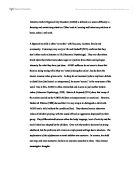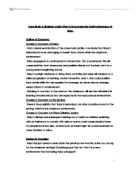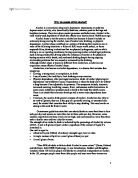ADHD used to be thought of as some brain injury, maybe at childbirth and there were also suggestions that those who are brought up in a dysfunctional family are prone to the condition. However, much research have criticised these insinuations in light of Positron Emission Tomography (PET) scans, research regarding damage to the foetus (fetal alcohol syndrome, FAS), drugs (cocaine), toxins (lead in soil and dust, but this is found only in a small number of cases) and genetic innovations (at least 1/3rd of fathers who endure ADHD have a son also diagnosed with ADHD), Morrison & Stewart (1971) found that hyperactive children had at least one hyperactive parent. There are some suggestions that ADHD may be linked to a genetic thyroid disorder. Frontal lobes of some people suffering from ADHD use a smaller amount of glucose and demonstrate less electrical activity
The most promising treatments available for ADHD and which is lead by scientific research is that of behaviour modification treatments and psychoactive stimulants.
The use of psychoactive stimulants is not encouraged as a first option in the treatment to ADHD. Nonetheless, if this option is taken then are many guidelines to be aligned by and decisions to make. These stimulants are thought to ‘speed up’ the brains activity and in doing so, increasing the levels of dopamine and serotonin in the frontal lobe. This regulates inattention and calms impulsivity so the brain needs less stimulation. In essence, it appeases the individual so they can work through daily life more efficiently.
Treatment is determined by consideration of severity, assessed by symptom checklists, direct observation of the child at home and at school and finally with careful questioning of the child’s parents and teachers (Woods, S., 1999). If it has been determined that the child needs to be put on medication then it always will begin with the lowest possible dose and subsequently increased until the desired therapeutic effect is acquired (a continuous and even suppression of symptoms throughout the day). Another factor affecting the drug dosage is the weight of the person with ADHD. It is generally 1mg of the required drug to every 1kg of the person as a starting point (AAP website). However the final dose varies from individual to individual. The most common prescriptions for treatment of ADHD are Dextroamphetamine, Methylphenidate and Ritalin. If a person is acceptable on 5mg of Dextroamphetamine, then the common practice is that they will usually display the same behaviour and emotions on 10mg of Methylphenidate if it is all applied in one dose. Dextroamphetamine and Methylphenidate are acquired in short-acting and sustained release forms (SR) (Woods, S., 1999). Ritalin however is given more than once a day, usually the morning, lunch and a half hour or so before the person is due for bed. There is sometimes confusion as to what type of the drug to get, but it is always better to obtain the Brand name instead of the generic forms. If one medication does not work for a child with ADHD the AAP (American Academy of Paediatrics) recommends that 'when the selected management for a child with ADHD has not met target outcomes, clinicians should evaluate the original diagnosis, use of all appropriate treatments, adherence to the treatment plan, and presence of coexisting conditions.' If necessary second line treatments may be applied if the drugs mentioned above do not exhibit the desired effects. These comprise of triclycic antidepressants such as Imipramine or Desipramine or bupropion (Wellbutrin).
Once a dose is determined then follow-up checks are carried out (e.g. monthly). Parents are asked to monitor the child’s behaviour by using the ‘Conner’s Parenting Rating Scale’ (1990). In addition to this there is also a teachers rating scale. This way, the behaviour of the child is seen and it can be determined as to whether or not the dosage is having the desire effect. Side-effects to these drugs are minimal but not chronic. The most frequent are depressed appetites and difficulty in sleeping. Occasionally, side-effects may be confused with the symptoms of the child’s condition. Thus, to avoid this problem and determine if the side-effects are medication related a base-line symptoms list should always be carried out and completed before the initial medication trial. The National institute of Mental Health state that due to the a large amount of controversy over the medication used to treat ADHD, it is essential that the parents know all the benefits and risks of the stimulant drugs ().
Another method of treatment is that of behaviour modification.
We view the normal activation of these systems (i.e. rewards and punishment) as being essential to the brains’ capacity to process and store in the memory the feeling component of experience- pain like guilt and pleasure like joy. With no mechanism of conditioned expectancy developing in children with ADHD, they have little or no reflexive activation in the reward or punishment systems. Because of this a child can’t anticipate the consequences of their actions. They have no internalisation of abstract concepts, moral or humanistic conscience. All due to this, the child feels no emotion when a significant other leaves their life, what only remains for them is emptiness.
The behavioural modification method used towards very young children with this illness is on ‘play therapy’. Toys and books, which are of interest to the child, is where therapeutic correction takes place. Positive behaviour is rewarded and negative behaviour is discouraged. There are home management programs associated with this treatment. It is like the reward /punishment theory. Good behaviour the child demonstrates is paired with him getting to experience good feelings, but disobedient is associated with bad. Here the therapist is like the parent. He nurtures and enculturates the child’s life around them, teaching the parents also. However, this is a very long process and treatment must be continuous and one is obliged to wait until the brain matures and is capable of processing psychic feelings.
Immediacy, consistency and constancy.
In all areas and aspects of a child's’ life with ADHD, the emphasis is on immediacy, consistency and constancy. In this way it facilitates the conditioning process and any problems in the child’s behaviour can be seen in problems towards the conditioning process. Due to this it is essential that the therapist to have high-quality behaviour management techniques and instruct the parents appropriately. The notions of constancy, immediacy and consistency are not easily internalised for a child with ADHD. The child acknowledges these concepts only by constant reassurance and giving him a safe and comfortable environment. But as changes in any person’s life are unavoidable, parents must remember to keep explaining everything to the child.
Symptoms of ADHD are very hard to recognise, and it is commonly seen as just bad parenting. Due to this the teacher of the child will often blame the parents and this can cause breakdowns between both. However the opposite is needed for the child to feel normal and wanted by both parties. Another problem in this situation is that the child may behave a lot better in front of his father/mother; whichever demonstrate a more authoritative parenting style. This can lead to tension in the house, which the child may feel responsible for.
ADHD can be looked at in a child-environment perspective. If this is the case then an unstable environment provokes more symptoms. If parents give more structure, mild symptoms may fade away without medication. ADHD children have problems in processing psychic feelings so they may press for more permissive environments. If good behaviour receives no attention then they will gradually turn to a more negative style to seek for attention. A common symptom of ADHD is high distractibility and a poor ability to attach relative meaning to stimuli, or habituate to them. Parents, teachers and therapists need to be very direct in communication and feedback to the child such as eye contact, clear and distinct voice, holding child’s upper arms (Woods, S., 1999). This cannot be overemphasised in the use of behaviour modification towards the treatment of ADHD in children and is completely essential to the concepts of consistency, constancy and immediacy.
There obviously are many activities that a child may become fixated and totally concentrated on. The problem arises when it is time for the child to disengage in the activity. Negative behaviour can become very frustrating for carers, and an ADHD carer needs to withstand a lot. Instead method of time-out or response cost techniques should be applied. Due to their short attention span, all consequences for the child need to take place as immediately as possible and ought to be short in duration (10-15mins.). As for all children, but especially those with ADHD, criticism can be taken quite critically, so it must always be stressed that there is a difference between the child and the behaviour.
ADHD children have difficulties with self-control and parents often expect age-appropriate behaviour without giving much warrant to positive behaviour. This can leave the child with a poor self-image. At the end of each day parents and caregivers are encouraged to put aside the bad behaviour of that day and let the child start the new day afresh. However it is better to let this policy hold onto the ‘good behaviour’ as it reinforces the child’s feeling of self worth and helps to restore the balance between the good and bad psychic feelings the child is experiencing.
Children with ADHD are very perceptive of events happening close to them- moods, feelings of others. This should not be mistaken with a capacity of empathy or the ability to internalise these in a longer-lasting form. As the child cannot keep feelings associated with a certain person in mind, they seek out their continual presence. The child may also behave negatively, as they see any feeling associated with the person as at least ‘some feeling and attention’. Dogs are extremely loyal and show open emotions of joy and happiness upon seeing a person.
The inner emptiness and coldness that ADHD individuals experience when not in the company of others cannot be overemphasised. Through constant socialising to find a relief of this internal state they can be very demanding in their behaviour towards others and often alienating them in the process. This is extremely important for adolescents and adults with ADHD. A way of dealing with this is by support groups. In this way they can share frustrations and ambitions and as everyone is going through the same things then they feel they are not alone and they understand each other more. There was a reference to one woman (Abnormal Psychology) who suffered from ADHD who went along to many different groups to make friends. She had problems keeping these friends, as she was so demanding towards what they gave and because of her inattention problems.
There is much research concerning new treatments of ADHD. Brain imaging and conditions during pregnancy and early childhood shows potential. The National Institute of Mental Health is trying to determine the different clusters of symptoms displayed (i.e. conduct disorder or anxiety) with ADHD and then see what the differences between the children are. In this a treatment for each one may be distinguished (). At the moment however, this is not known so we must hold onto the methods mentioned above. Indeed there are many more ranging from psychotherapy, restricted diets (Feingold, 1971) to special coloured glasses but these display too many flaws and not enough scientific evidence or ‘cure’ rates supporting them.
Diagnostic Criteria for Attention Deficit Hyperactivity Disorder.
∙ The child must show either significant ‘inattention’ or significant ‘hyperactivity-impulsivity’ (or both).
∙ Inattention is indicated by any six of the following:
- Often fails to give close attention to details or makes careless mistakes in schoolwork or other activities.
- Often has difficulty sustaining attention to tasks or play.
- Often does not seem to listen to when spoken to directly
- Often does not follow through on instructions and fails to finish chores, homework or other duties.
- Often have difficulty organising tasks and activities.
- Often avoids, dislikes, or is reluctant to engage in tasks that require sustained mental effort.
- Often loses things necessary for tasks or activities (e.g. toys, pencils, books, tools).
- Is often distracted by extraneous stimuli.
- Is often forgetful in daily activities.
∙Hyperactivity-Impulsivity is indicated by the presence of six of the following, persisting over a period of at least six months:
- Often fidgets with hands or feet or squirms in seat.
- Often leaves seat in classroom or in other situations in which remaining seated is expected.
- Often runs about or climbs excessively and reports feelings of restlessness.
- Often has difficulty playing quietly.
- Is often ‘on the go’ or often acts as if ‘driven by a motor’.
- Often talks excessively.
- Often blurts out answers before questions are completed.
- Often has difficulty waiting turn.
- Often interrupts or intrudes on others
∙The onset of the problem must be before the age of 7.
∙At least some of the symptoms must be present in two or more settings, such as at home and in school or school and play with peers.
∙The behaviour must interfere with developmentally appropriate social, academic or occupational functioning.







